Rosenberg, Charles (McKechnie Section 3)
See also Sections Two and Six
One of the best-known, most prolific and most successful of silhouette artists, famous for his many profiles of royalty, recorded as Carl Christian Rosenberg by Jackson (Dictionary) and, correctly, as Charles Rosenberg by Coke (The Art of Silhouette). Some prints were engraved after Rosenberg's profiles of royal sitters by J. C. Stadler (see Appendix Two).
At least two of Rosenberg's sons were artists; it is possible that portrait miniatures on ivory or landscapes, signed 'Rosenberg', were in fact the work of one or other of these sons, since the quality of their father's silhouettes does not suggest that he would have worked successfully in these other media.
Rosenberg's full name, and his country of origin, have alike been subjects of debate. Some writers have referred to him as Charles (or Carl) Christian Rosenberg. In the entry for his marriage in the register at Bath Abbey, however, he is referred to simply as Charles Rosenberg. With regard to his national origin, conflicting evidence is offered by his earliest known advertisement (Bath Chronicle, 11 October 1787), which states that he is 'from Vienna', and by a later announcement (which appeared in two Bath newspapers in January 1794; I shall quote it in due course) in which he is described as 'a native of Hungary', although the 'late Queen of France' (who was, of course, Austrian) is referred to as 'his unfortunate countrywoman'. On balance (especially if we bear in mind that Hungary was part of the Austrian Empire at the time) it seems probable that Rosenberg was Austrian by birth.
Previous writers have given Rosenberg's date of birth as 21 November 1745, and have stated that he came to England in the entourage of Queen Charlotte when, as Princess of Mecklenburg-Strelitz, she arrived in 1761 to marry George III. It has been said that Rosenberg was a page of fourteen years old, but, if the generally accepted date of his birth is accurate, he must have been aged fifteen or sixteen.
We know from the advertisement cited above that in due course he settled in Bath, that he was certainly working there at the age of forty-two, and that (unless the marriage which was to take place in 1790 was not his first) he was still a bachelor. Above all, the advertisement (quoted below) indicates that Rosenberg was by now well established as a silhouette artist who enjoyed royal and aristocratic patronage:
Mr. Rosenberg, (from Vienna) at Mr. Tucker's, St. James' Street, Bath, having had the honour of taking the Likenesses of most of the Princes of Germany, as well as Their Majesties, the Prince of Wales, Duke of York, and the Princesses at Windsor, begs leave to acquaint the Nobility, Gentry &c., that he takes the most excellent LIKENESSES IN PROFILE, which he paints on glass, in imitation of stone, agate, &c., and so never to fade, in a manner superior to anything ever attempted in this country. He flatters himself to give satisfaction to all those who shall honour him with their Commands.
PROFILE LIKENESSES painted for Lockets, Rings, &c. Mr. Rosenberg also acquaints the Inhabitants of Bath that he can accommodate them with the most Striking Likenesses of the Royal Family.
Any person may be taught, if unacquainted with drawing, on the most reasonable terms.
As the 'Princes of Germany' head the list of important personages whose likenesses Rosenberg had already taken, it seems more than likely that he had returned to the Continent since his arrival in England in 1761, and had achieved some success in Germany. Although Rosenberg painted many silhouettes of royal sitters, none of these appear to date from the 1760s or 1770s, and the older children of George III are shown as adults. The royal groups which are known (they include a silhouette of the Duke of Mecklenburg-Strelitz, the brother of Queen Charlotte) all date from the late 1790s.
Whether or not Rosenberg was in Germany during the early 1780s, or even earlier, this advertisement remains the earliest known reference to his work as a profilist in Britain. At the end of the eighteenth century Bath could almost have been described as the second capital of England, with a population (including many visitors, mainly seasonal) of about thirty thousand. Many eminent people visited the city, and it was probably for this reason that Rosenberg (well-acquainted with many members of the aristocracy and other prominent figures as a result of his association with the Court) chose Bath as his centre.
As Rosenberg was using at this time a trade label without an address, it is possible that he only spent the winters in Bath, and travelled elsewhere in the summers. There is a well-known group of profiles of royal sitters (illustrated by Jackson; Dictionary) taken by Rosenberg in 1788 in Cheltenham. (These were probably used later for the taking of 'stock' profiles).
1150, 1151
This group includes a portrait of the Duke of York. Rosenberg must have been very quick to make arrangements to take the Duke's profile, for, although a special extension was built on to Fauconberg House, for the purpose of accommodating the Duke, he arrived in Cheltenham on a Saturday and left the following day to visit his brother, the Prince of Wales, already estranged from his father (see Roger Fulford, Royal Dukes, London 1933). It is because one of these profiles bore the date 1788 that we know that Rosenberg visited Cheltenham during this year. Mills records an example inscribed 'Rosenberg, of Bath, at Mrs. Barclay's, Ye Temple', which suggests a spell in London; but he gives no date.
By 1790 Rosenberg had established himself in Bath. In that year he married Elizabeth Woolley, who came from a family of artistic bent; it was probably even more from her than from Rosenberg himself that the artistic ability which was to show itself in the couples' descendants stemmed. The marriage took place on 4 February in Bath Abbey. The register shows the names of Charles Rosenberg, Elizabeth Woolley, and the following witnesses: Susanna Woolley, Samuel Robines, Charles Drake, Elizabeth Drake and Elizabeth Lewis.
In the list of artists in the Bath Guide for 1791 Rosenberg's name is given, with an address in North Parade. The Bath Directory for the same year, however, lists Rosenberg as working at 'Orange Grove', he is described as 'Profile-Painter to Their Majesties'. The two entries probably refer to different, but adjacent addresses; either one was used as a dwelling, and the other as a studio, or the address 'Orange Grove' was used to indicate a house in North Parade.
In 1792 an advertisement appeared both in the Bath Chronicle and the Bath Herald and Advertiser; in the former, on 1, 8, 15, 22 and 29 November, and on 6 and 13 December; in the latter on 27 October and 3 November. It reads thus:
MR. ROSENBERG
Profile-Painter to Their Majesties
Takes the most Striking Likenesses in Etruscan and Anti-Etruscan methods. He begs to inform the Nobility and Gentry of his return to his shop on the North Parade, which he has fitted up in a Most Elegant Manner, and where constant attention is given.
The time of sitting is one minute, and the price from 7s. 6d. to one guinea.
Mr. Rosenberg presumes to solicit the polite attention to his partners, the Messrs. Stephany and Dresch, the most eminent sculptors in ivory in Europe, whose performance claims universal admiration, and who will execute any design for Rings, Bracelets, Lockets, or for Cabinet pieces. A variety of their work is to be seen at the above shop where they are sold.
A very fashionable assortment of Trinkets, Toys, artificial Flowers, Jewellery, and French fancy feathers.
From this it appears that Rosenberg had returned from a summer tour, also that, in order to augment his income, either Rosenberg or his wife had opened a shop at their premises. G. Stephany and J. Dresch (also spelt Drach) were two artists who appear to have shared the Rosenbergs' premises in Bath until at least 1797, when they moved first to Harington Place, Bath, and later to Jermyn Street, London. Stephany (who may have been born in Augsburg, according to Bénézit) exhibited at the Royal Academy 1791- 1803; one exhibit was marked as from 'Stephany and Dresch'. I have illustrated a typical ivory carving by these artists, who were noted for their carving of ships.
1173
In the Bath Chronicle of 5 January 1792 there appeared an advertisement (repeated on 12 and 19 January) which reads as follows:
STEPHANY
Sculptor in Ivory, from abroad.
At Mr. Rosenberg's,
North Parade, Bath.
Flatters himself that he is in possession of an Art peculiar to himself & superior to any ever known, or practised in this or any other Kingdom in Europe, of working all devices in ivory to any Drawing or Design imaginable for Rings, Bracelets, Lockets, Snuffboxes, Fauxmonts, &c. His works have been allowed by the most eminent artists to be the most envious performance ever exhibited, as part of the work is so fine, that a glass is necessary to discover its beauties.
Specimens to be seen at Mr. Evill's, Jeweller, Market Place, Bath. (this last on 5th. Jan. only)
A similar advertisement in the Bath Chronicle (3 and 17 May 1793) begins, 'Rosenberg, Stephany & Co., Sculptor in ivory to Her Majesty ...'; it was repeated on 20 and 27 April and on 4 May 1793 in the Bath Herald and Advertiser. On 25 January 1797 an advertisement by G. Stephany and Dresch appeared in the Bath Chronicle 'ssued from 2 Harington Place and announcing an exhibition of the artists' ivory carvings.
By the time the Rosenbergs' association with Stephany and Dresch had begun, two sons had been born to them. Thomas Elliott (see Section Six) was born on 3 October 1790 and christened in Bath Abbey on 3 November. In 1817 he married one Mary Wood. On 19 July 1792 a second son was born; he was named Charles, after his father. He, too, was to become an artist. Silverthorne's Bath Directory for 1837 lists Charles and 'Miss M. Rosenberg' as 'Teachers of Drawing' at 7 Walcot Parade. Miss M. Rosenberg was presumably Elizabeth Maria Antoinette, the Rosenbergs' third child, who was christened in the Abbey on 16 January 1794. The event was announced both in the Bath Chronicle (17 January) and, under 'Bath News', in the Bath Herald and Advertiser (18 January). The announcement ran as follows: 'Mr. Rosenberg of this city, a native of Hungary!, in respect of the memory of his unfortunate countrywoman, the late Queen of France, had yesterday his infant daughter baptized Marie Antoinette: Her Grace the Duchess of Devonshire, Lady Elizabeth Foster, and the Marquis of Hartington, honoured Mr Rosenberg on this occasion by personally attending as sponsors.' The Marquis of Hartington was under four years old at this time. The Duke of Devonshire was not among the party on this visit to Bath; it was probably at about this time that he was at variance with his wife about her gambling debts, and about a pregnancy for which he was not responsible. It might seem strange that, while the Devonshire family was in a state of such discord, any of its members should have taken the trouble to act as sponsors to the second son of a profilist. The probable explanation is that Rosenberg's years at Court had given him an entree into the leading Whig circles of the day. There was great rejoicing in the country after Admiral Howe's great sea victory off Ushant on 1 June 1794. The celebrations in Bath included the display of illuminated paintings. Rosenberg contributed several examples, of which three were as follows:
(1) A British sailor, with a cup of grog in his right hand and the Union Jack in his left, trampling on the French flag; motto: 'Lord Howe, he nicked 'em'.
(2) Admiral Howe, his brow encircled with a laurel surmounted by an earl's coronet and inscribed, 'To the Victorious Admiral, the thanks of the nation'; at the base, two wooden legs, inscribed with the names Bowyer and Paisley (two rear admirals, each of whom lost a leg in the action).
(3) 'George Rex', his brow encircled with a laurel surmounted with the British crown and inscribed, 'To our Virtuous King, the congratulations of the nation.'
It is clear that by this date Rosenberg was established as a well-known citizen of Bath. He was still living in North Parade.
On 12 February 1796 there appeared in the Bath Chronicle an announcement which indicates an unexpected widening of Rosenberg's activities: 'Mr. Rosenberg has received a curious assortment of WORK, WRITING, and other BOXES, most elegantly worked in Straw, far superior to any other yet seen in Bath. Mr. Rosenberg manufactures all the ELASTIC ARTICLES himself: Royal Brunswick-York Monitors universally approved of to brace back the shoulders as well as being very ornamental.' Presumably these 'monitors' were a type of decorative braces, perhaps introduced to correct the fashionable slouch of the 1790s. It is interesting that even braces (made, apparently, by Rosenberg himself) were given a royal name.
A third son was born to the Rosenbergs in 1796, an event recorded in the Bath Chronicle on 28 July. The boy was christened (in the Abbey) Frederick, after the Duke of York. The Duke in fact was godfather to the child, although he was represented at the christening ceremony by proxy. (The date of birth of Rosenberg's fourth and youngest son, Samuel, is unrecorded; he was to die in 1821).
An excerpt from the Bath Chronicle of 21 January 1797 reveals the extent of Rosenberg's production as a silhouette artist: 'Mr. Rosenberg, Profile Painter, announces that he has now a collection of 3,000 profiles.'
On 11 April 1798 an advertisement (the first of several inserted during that year in at least three Bath newspapers) indicated that Rosenberg had moved to a new address:
No. 14, GROVE, BATH.
CHARLES ROSENBERG, Profile-Painter to their MAJESTIES and all the ROYAL FAMILY, respectfully informs the Nobility and Gentry, that he is removed from the North-Parade TO THE ABOVE HOUSE, where he takes the most perfect LIKENESSES in his usual and approved style; and where the largest Collection of PORTRAITS of the most celebrated Characters in the kingdom is exhibited gratis.
C. R. having declined every other business, means to apply himself solely to a profession in which he has the pleasure to say he has given universal satisfaction; — assiduity, constant attendance, and gratitude, shall render him deserving of the future favours of his friends.
All the Likenesses which C. R. has taken, during ten years residence in this city, have been and will continue to be carefully preserved for the satisfaction of relatives, &c, who may wish to have copies.
Time of sitting One Minute only price from 7s. 6d. to one guinea, frames included.
The very excellent, genteel, and airy LODGINGS, in the above House, to be lea, furnished or unfurnished, at an easy rent.
Rosenberg was to occupy the house at 14 The Grove, as ratepayer, for the remainder of his days in Bath, and silhouettes bearing this address must be dated April 1798-c. 1815. Since he states that he has 'declined every other business' (a reference no doubt, to the selling of various non-artistic products, as well as to his partnership with Stephany and Dresch), it seems that by this time he was able to support his family by his artistic work alone (apart from the rent received by letting some of the rooms in the house).
In May, Admiral Sir Sydney Smith escaped from his imprisonment in Paris, an event which prompted Rosenberg (who had apparently taken several profiles of him, though none are known to me) to publish the following witticism in the Bath Chronicle on the 24th:
TO THE FRENCH DIRECTORS!
CITIZEN DIRECTORS!
Through the medium of newspapers having been informed that you offered a reward for the taking of Sir Sydney Smith, I beg to acquaint you, Citizen Directors, that I have taken him several times, but he has been rescued as often by a great number of friends, whom I could not resist. I now pledge myself to take him again, and to guard him until your Army of England comes here. You will be pleased to give orders to your General to call on me, and I will deliver him into your hands, providing the reward is paid in READY MONEY. I am proud of having the honour to subscribe myself, &c. &c.
C. ROSENBERG
Profilist to Their Majesties
14, The Grove
By June, the artist had no doubt let some of the 'airy lodgings' in his house, for he was now in Harrogate, possibly having previously visited Leeds. The following advertisement appeared in the Leeds Mercury on 30 June:
MR. ROSENBURGH
(from Bath)
Profile Painter to Their MAJESTIES
and the ROYAL FAMILY
(Who has had the honour to give Satisfaction in his Profession to the first Families in the Kingdom), BEGS leave to inform the Nobility and Gentry. That he is arrived in HARROGATE, and by a Sitting of ONE MINUTE ONLY, he takes the most Striking LIKENESS IN PROFILE. Painted on glass, superior to any in the Kingdom.
Prices from 7s 6d to £1. 1s.. Frames have included. Likenesses for Lockets, Rings, Bracelets, &c. &c. &c., and Family Pieces in whole Lengths, neatly grouped.
An infinite Variety of Specimens to be seen at his Lodgings, at Mr. Burnand's, Coach-Maker.
Ladies and Gentlemen waited on in their own Apartments and any Family or Party will be waited on in the Neighbourhood without any extra Charge.
June 20th. 1798
Though Rosenberg may have visited other northern towns during the summer months, by the autumn he had returned to Bath. He now discovered another novel source of income, as the final paragraph of the following advertisement Bath Chronicle, 25 October and 1 November; Bath Journal, 29 October) shows:
MR. ROSENBERG,
PROFILE PAINTER
To their MAJESTIES and ROYAL FAMILY,
Begs leave to inform the Nobility, Gentry, &c. that he is returned to No. 14, GROVE, BATH, where, In a sitting of one minute only, he takes LIKENESSES in his usual stile, (painted on glass) superior to an attempted before. and where the greatest Collection of Characters in the kingdom is to be seen and constant attendance will be given.
Price from Seven and Sixpence to One Guinea.
LIKENESSES for Rings, Caskets, Braces, Toothpick-Cases, &c. — Ladies and Gentlemen waited on at their apartments.
N.B. In addition to the well-regulated Weighing Machine, Mr. R. has added a Measure, where Ladies and Gentlemen may ascertain their weight and height at One Shilling the Season.
It is recorded that during 1799 the Prince of Wales sat to Rosenberg. The artist appears in the Lodging House List of the Bath Directory for that year as living at 13 The Grove. (Unless he had leased the house next to No. 14, conceivably for the purpose of taking the Prince's profile, No. 13 was probably a misprint for No. 14.) The Bath Directory for 1801 has the entry, Rosenburgh, Charles, Profile-Painter, 14, The Grove'. Life for the family appears to have continued in much the same fashion until another advertisement (Bath Chronicle, 25 April 1804) announces a change:
We have pleasure to inform the respectable inhabitants of this city, that in compliance with the wishes of several ladies, Mrs. Rosenberg has been prevailed upon to open a Day school for children. Those who know Mrs. R's attention to her own family, will say how capable she is to undertake this:
Delightful task! To rear the tender thought
To teach the young idea how to shoot
And pour fresh instruction o'er the Mind.
The verses are by James Thomson. We do not know how long Mrs Rosenberg continued to manage her school, but there would probably have been an interruption in 1805, when she bore another daughter. Ann, who was christened on 16 March in the Abbey.
On 14 April 1808 the following advertisement appeared in the Bath Chronicle:
At the particular request of His Royal Highness the Prince of Wales, King Lewis XVIII of France honoured Mr. Rosenberg with a sitting for his Likeness, as did the rest of the Bourbon family in England. H.R.H. Duchess of Brunswick also honoured Mr. R. with a sitting, at the desire of the Royal Princesses. Mr. R. Flatters himself that the above Illustrious Personages are not inferior in point of Likeness to those he had the highest honour of taking of Our Most Revered Sovereign, and his Royal Patron the Prince, and may be had of him, at the usual price, from one to two guineas, including elegant frames, from his house at No. 14, The Grove, Bath.
In 1807, during the upheaval of the Napoleonic Wars, Louis XVIII had taken refuge in England, where he was obliged to remain until 1814. It seems likely that Rosenberg had taken a profile of Louis XVIII, who may well have visited Bath in 1808. I know of no more advertisements by Rosenberg. Some of the rate books for the Abbey Ward, dating from the early 1800s, are extant. The following entries, which relate to 14 The Grove, confirm that the Rosenbergs were ratepayers for this house at least during 1805 and 1806:
1805 21st. Feb. Mr. Chas Rosenberg
10th. April Mr. Chas Rosenberg £1. 12s. 6d. (next to the Mill House)
30th. June Mr. Chas Rosenburgh £1.12s. 6d. [altered to 'berg' by the rate collector]
13th. Sept. Mr. Chas. Rosenberg £1. 12s. 6d.
14th Nov. Mrs. Rosenberg £1. 12s. 6d. (next to the Mill House)
1806 23rd. Jan. Mrs. Rosenberg £1. 1.2s. 6d.
We have to rely on entries (not always up-to-date, and occasionally confusing) in the Bath Guide and Bath Directory for Our knowledge of Rosenberg's movements during the next few years:
1812 Rosenberg, Profile-Painter,
Wade's Passage [Bath Guide]
Rosenberg and Son, Profile-Painters,
Wade's Passage [Bath Directory]
Rosenberg & Son, Profile-Painters,
Orange Grove [List of Artists, Bath Directory]
1813 Rosenberg, Profile Painter,
Wade's Passage [Bath Guide]
1815 Rosenberg, Drawing Master,
14, The Grove [Bath Guide]
1816 Rosenberg, Drawing Master,
14, The Grove [one copy of Bath Guide]
Rosenberg, Profile-Painter,
Wade's Passage [another copy of Bath Guide]
The last entry, which would have been sent in during 1815, may refer to Charles Rosenberg. I think that the phrase 'and Son' indicates Thomas Elliott Rosenberg, and that he is the 'drawing master' referred to in the entries for 1815-16. The illustrated print by J. C. Stadler of George III (see Appendix Two) is inscribed 'Rosenberg and Son' and dated 1812. The references to 'Wade's Passage' are puzzling, as this cannot be the same address as 14 The Grove, which was on the far side of Orange Grove from the Abbey. During this period Wade's Passage ran from a point near the house of General Wade, in the Abbey Churchyard, into Orange Grove. A number of old gabled houses, some of them built on to the north side of the Abbey, still stood, and Wade's Passage ran between these and the houses on the Orange Grove side of General Wade's house. Most of these houses, including those built on to the side of the Abbey, were demolished during the nineteenth century, and today so little of the former Wade's Passage remains that the name has ceased to be used. Possibly Rosenberg took a studio in Wade's Passage for a time, hoping to acquire further business, while retaining 14 The Grove as the family home.
Rosenberg probably ceased working as a profilist C. 1815, when he was about seventy, and he soon returned to the Court, having left his sons in Bath. It is certain that on 28 April 1816 he was appointed King's Messenger to George III (see Royal Household Index Ref. L C. 3.68 (173)). On 15 April 1819 he was dismissed from his post but was reinstated in July (see V. Wheeler-Holohan, The History of the King's Messengers, London, 1935). It has been suggested that during the intervening three months Rosenberg became naturalized. As the King, being invalided, was not in power, Rosenberg's post must in any case have been a sinecure at that time. After the accession of William IV in 1830 Rosenberg, now nearly eighty-five, was reappointed King's Messenger by warrant on 24 July (see the Royal Household Index: L C. 3.70 (5)). In 1834 he was succeeded in the post by William Radford, whose warrant was dated 4 March 1834 (see op. cit.: L C. 3.70 (110)). (Jackson, who quotes Rider's British Merlin, 1829, stated that Rosenberg remained in the post throughout the reign of George IV).
Rosenberg had begun his association with the Court in 1761; this was not forgotten, for, as the Court and City Register (1817-34) states, he was granted an allowance on retirement of £140 a year from 1834 onwards (see the Royal Household Index: L C. 3.50). The old artist was still living at Court during the early years of the reign of Queen Victoria, who is said to have called him 'Rosie'. It is said that, at a very advanced age, he took a profile of the Queen.
Charles Rosenberg died in 1844, aged ninety-nine; it is believed that he was buried at Brompton Cemetery, London. He had outlived his son Thomas Elliott, who died on 17 June 1835 (Foskett), by thirteen years. His wife died on 30 June 1853.
A portrait of Rosenberg, by his eldest son, is recorded by Jackson: 'Of Carl Rosenberg himself there is a fine life-size portrait painted by his eldest son, Thomas Elliott, showing him as a handsome man between fifty and sixty years of age, dressed in the Court or Windsor uniform. The canvas bears in the corner a representation of his greyhound badge as King's Messenger; the badge has the heraldry and the name of George III.' Jackson's reference to the badge indicates that the portrait must have been painted between 1816 (when Rosenberg was first appointed King's Messenger) and 1820 (the year of the death of George III), but Rosenberg (who was about seventy in 1816) must have been older at the time than Jackson suggests.
Rosenberg was painting black profiles in Britain from c. 1787 until perhaps c. 1815, possibly after a previous period of work on the Continent. He was therefore in practice for many years, and his work, not surprisingly, shows changes in style over this long period.
Bust-Length Silhouettes
A feature of all Rosenberg's bust-length work, whether silhouettes of the standard type or jewellery pieces, is the bust-line finish, which is perhaps more consistent in character than that of any other artist, as the illustrations bear out.
I will discuss first Rosenberg's bust-length silhouettes painted on flat glass. These show little detail, apart from rough brush work on the sitter's frills Hair is sparingly depicted. These profiles are usually housed either in oval hammered brass frames, or in the square hammered brass frames which were often used by Bath artists during the early 1790s. One illustrated example is (unusually) framed in pearwood, with a plain verre églomisé border.
1153
The usual sight measurement of profiles in the oval brass frames is 4⁷/₈ x 3⁷/₈ in. Most of the examples seen in these frames are backed by pink chalk-surfaced paper, the colour of which has now faded (except behind the profile) so that this pink paper bears a pink replica of the silhouette and further
traces of pink are visible on this backing under the edges of the frame. Underneath the pink backing there may be as many as eighteen pieces of old hand-made paper; in some cases notes are scribbled on them. This coloured backing may have been used to portray the 'in imitation of stone, agate, &c.' mentioned in one of Rosenberg's early advertisements published in Bath. It has also been suggested that it was intended to convey an allusion to the artist's surname.
Square brass frames appear to have been used c. 1792-97 (see Mills, Plate XXVIII; though described as 'painted on plaster', this example was probably painted on glass and backed with plaster).
Rosenberg's silhouettes on convex glass are painted in much the same style as those on flat glass: hair is rendered with straggling strokes, and frills are depicted with rough brushwork. The needle (apparently little used to render hair) was occasionally used to show the outlines of clothing. Some examples, dating from the 1790s, are framed with verre églomisé surrounds; others are in decorated oval wooden frames. In both categories, Rosenberg's work of this period is most attractive. After c. 1798, when the papier mâché frame began to be used, Rosenberg's profiles are more variable in quality. Many of these later profiles are backed with plaster.
Some of these profiles resemble those of William Hamlet the elder. On his profiles of royal sitters, however, Hamlet usually rendered the legend 'Honi soit qui mal y pense' fairly clearly, whereas Rosenberg rendered it with only a few scratches made with a needle.
Most of Rosenberg's work on convex glass, executed before 1798, is backed with Trade Label No. 2. Later work is backed with Trade Label No. 3 and later labels. It will be noticed on the illustration of Trade Label No. 2 that at the base of the oval is a sheet of paper, to the left of which appears a crested handle, and to the right of which geometric instruments are shown. These devices may indicate that the artist used a pantograph to reduce the outlines of heads drawn life-size.
'ETRUSCAN' AND 'ANTI-ETRUSCAN'
SILHOUETTES
In his advertisements issued late in 1792, Rosenberg offered 'striking Likenesses in Etruscan and Anti-Etruscan methods'. Since it is clear from advertisements issued at about the same time by Jacob Spornberg (see Section Six) that Spornberg used the term 'Etruscan' to describe his red profiles painted in line against a black background, and that these silhouettes were the outcome of an original idea conceived by Spornberg, then we must assume that the work advertised by Rosenberg was offered by way of commercial retaliation against Spornberg. I have seen no red against black 'Etruscan' profiles by Rosenberg. In the entry on him in Section Six I have illustrated a bust-length profile painted en grisaille, dating from after 1810, and backed with his Trade Label No. 9. The painting does not seem to be of high enough quality to lead one to attribute this piece to Thomas Elliott Rosenberg (who was a reasonably good painter of portrait miniatures), which indicates that it was presumably painted by Charles Rosenberg, and also suggests that his skill in painting a full profile in line was so limited that he may well have been unable to produce work of high enough calibre to compete with the 'Etruscan' work of Spornberg. Being aware of this, Rosenberg may in fact have decided not to produce any 'Etruscan' profiles after all although he had offered them in his advertisements.
A number of bust-length silhouettes in solid black, set against orange paper, have been seen, all of them obviously by Rosenberg; presumably these are examples of what the artist referred to as the 'Anti-Etruscan' style. (One example of this style, signed by Spornberg, q.v., has also been seen; no doubt Spornberg, in his turn, painted this by way of commercial retaliation against Rosenberg).
A few bust-length silhouettes by Rosenberg, painted in solid black against a fiery red, have also been seen. As I have said in Chapter Two, we do not know why he chose this colour for the background for these profiles, rather than the orange which he usually employed. Until further evidence comes to light, we must assume that this use of black against a brilliant red background was the nearest approach made by Rosenberg to the 'Etruscan' profile, and that he used the term 'Anti-Etruscan' to describe work painted in black against orange.
Full-length Silhouettes
A number of full-length silhouettes by Rosenberg (all painted on flat glass) are extant. Some show single figures, others show groups. Most are painted in dead-black pigment. Men's shirt-frills are inconspicuous, but painted in the same way as those on bust-length examples. Full-length work shows less use of the needle than bust-length work.
Some equestrian portraits are painted with added colour, in particular those of George III, on which the Sash of the Garter is shown in blue, and gold and white are used. The details of the trappings are skilfully painted. An outstanding example of these groups is The Esplanade at Weymouth. A peculiar feature of this group, however, as of some other examples, is that Rosenberg does not appear to have drawn his figures to scale beforehand. On this example he appears to have begun by painting the figures on the right (including the Prince of Wales); by the time he reached the figure of Sir William Fawcett, on the extreme left, he had to render this as being very slim. In another well known royal group (in the Royal Collection; illustrated by Jackson, Dictionary, Plate 36), also painted at Weymouth, the artist began on the left-hand side of the painting, with the result that the figure on the right appears thin.
The group entitled Mon Prince avec un Prince (in the Royal collection) represents the Duke of Mecklenburg-Strelitz and his nephew the Prince of Wales. It is painted in dead black, except for the riband of the Duke's Garter, which is shown by a flash of blue above his raised hand. This group may have been based on the renderings of these two figures in one of the Weymouth groups.
1167
The full-length portrait of the Reverend Edmund Nelson is severely plain. It may well be a good likeness, for it is possibly the fashionably long overcoat that gives the impression that the sitter's figure is elongated.
A rather muddily painted 'ceiling' of tree branches is shown on some of Rosenberg's group silhouettes.
Some of Rosenberg's full-length portraits were backed with the same pink chalk-surfaced paper which I have already described in the context of the bust-length profiles on flat glass. One example (the sitter is called 'Dr Samuel Johnson') was sold by Sotheby and Company, London, from the collection of R. W. Mudie, on 11 February 1932.
Mrs Peggy Hickman owns (and illustrates in Two Centuries of Silhouette) a group entitled Church, King and Constitution. This shows Brownlow North (Bishop of Winchester and Prelate of the Garter), George III and Lord Loughborough (Lord Chancellor), the last-named figure being heavily bedecked with gold. Another group, sold by Sotheby and Company, London, on 26 March 1962, showed George III, Sir William Gordon, General Goldsworthy and Lord Cheslegh. Such groups were no doubt concocted by the artist as good selling lines and were probably expensive. The highest price (one guinea) mentioned in some advertisements dating from the 1790s was probably charged for single-figure compositions in full length.
Although Mr J. A. Pollak owns a rare cabinet-sized piece in Rosenberg's 'Anti-Etruscan' (black against orange) style, most of the artist's examples were painted for jewellery pieces (see below).
1162
Silhouettes in Jewellery Settings
Rosenberg painted a number of portraits (chiefly of royal sitters) for setting in boxes, lockets and other articles of jewellery. He painted these pieces under flat glass with a slightly convex upper surface, in a style similar to that of the bust-length work already described, except in a few examples painted in the anti-Etruscan style.
Of the anti-Etruscan examples, those painted on lockets, toothpick cases, and patchboxes are the most common. Mr J. A. Pollak owns a fine tortoiseshell snuff-box, inlaid with gold and silver, showing a portrait of George III and taken in c. 1790; it is illustrated by Mayne. This is the only example known to me on which the orange paper does show some sign of having faded. The paper with which Rosenberg's jewellery pieces are backed is the thick, soft, chalk-surfaced variety with which some of his profiles of the standard type are backed (I am referring to those backed with pink paper).
On some jewellery silhouettes of royal sitters, the Order of the Garter is shown, painted in blue. Since the riband of the Order is worn from the left shoulder to the right hip (where it bears the gold star), more of the riband is shown on portraits showing the subject to sinister, whereas the star is shown on portraits showing the subject to dexter.
Trade Labels
Ten trade labels of Rosenberg are known. All are illustrated.
No. 1 is simple in design and is headed by the Royal Coat-of-Arms. It reads, 'ROSENBERG, PROFILE PAINTER to Their MAJESTIES and Royal Family, fecit.'. It has been seen on bust-length profiles on flat glass, in oval hammered brass frames, painted during the late 1780s, when the artist had no permanent address in Bath. One example, dated 1788, and inscribed 'Cheltenham', is known. Since a profile by Rosenberg (illustrated in Chapter Four) dated 1791 bears Trade Label No. 2, we can assume that Trade Label No. 1 had ceased to be used by this year.
111
No. 2 has been seen on bust-length profiles, either on flat or on convex glass and in some cases with verre églomisé surrounds, and either in large oval hammered brass frames or in pearwood frames. A silhouette dated 1796, bearing this label, has been seen; probably the label was in use until the Rosenbergs moved to 14 The Grove, Bath, in April 1798. The text is as follows:
Mr. Rosenberg
of Bath
PROFILE PAINTER
To Their Majesties & Royal Family
Begs leave to inform the Nobility and Gentry that he takes the most striking Likenesses in Profile, which he paints on Glass in imitation of stone that will never fade.
Time of Sitting One Minute.
Price from 7s. 6d. to £1. I. 0. Family Pieces
whole Lengths in various Attitudes
NB. Likenesses for Rings, Lockets, Trinkets and Snuff Boxes
Skelton 23 Hay Market
An example of No. 3 is on the reverse of the fine group taken on the Esplanade at Weymouth, in the collection of the Right Hon. Earl Spencer. The comparatively youthful appearance of the King and Queen in this group suggests that this label was probably the first of a series in use at 14 The Grove, probably 1798-1800. It has a scalloped surround of stars, and is printed on white paper.
1166
No. 4 is similar in design to No. 3 and is also on white paper, but differs typographically. An example is on the reverse of the full-length profile Of the Reverend Edmund Nelson, who died on 26 April 123 1802.
123
If this was not a 'repeat' profile, the label may have been used c. 1800-1801. An example on blue paper is on the reverse of the illustrated profiles of the Earl and Countess of Chatham.
1157, 1158
No. 5 is similar in design to Nos 3 and 4 and is likewise printed on white paper. There is an example On the bust-length profile of George III (shown wearing glasses) in the Royal collection. According to C. E. Vulliamy (Royal George, London, 1937) when in Weymouth in 1802 the king is known to have said, 'The complaint of the eyes does not mend.' This label may have been in use c. 1802-1804. It shows the name of the printer, Savage.
1159
The text of No. 6 is similar to that of No. 5, but the design (in the Adam style) is different; there is an ornamental surround with a pattern of foliage, surmounted by an urn, and with a bow beneath and struts at the sides. The example which has been seen is printed on green paper; it was on a silhouette taken perhaps c. 1806.
1160
Both text and design of No. 7 are similar to those of No. 6, but No. 7 is printed on what was originally white paper, with the name 'ROSENBERG' printed in 'hollow' type. It has been seen on a silhouette of a woman (possibly Queen Charlotte) seated at her tea table. This silhouette (probably c. 1807) may have been a copy of an earlier profile, reproduced later for a 'stock' selling line.
No. 8 has a square ornamental surround with a leaf design, and the text contains the spelling 'Dutchess'. Examples printed on grey and blue paper have been seen. It was probably used c. 1808-1809.
1161
No. 9 has the same wording as No. 8, contained within an oval surround with a design of swirling leaves. 'ROSENBERG' is printed 'hollow', and the spelling 'Duchess' is used. Printed on greenish blue paper, the label was probably used c. 1810-11. It has been seen on the back of an indifferent 'cameo profile of Rear-Admiral Christie, illustrated in Section Six.
1564
No. 10 is the only trade label of Rosenberg's which bears the words 'Prince Regent'. The Regency Bill was passed in the House of Commons on 31 January 1811 and received the Royal Assent on 5 February, but it was not until the end of the year that the King was regarded as a 'confirmed lunatic' (see Vulliamy, op.cit.). This label (possibly printed late in 1811 and certainly by early 1812) was probably in use until the end of Rosenberg's career as a profilist.
There is an example on the large silhouette of George III (in the Royal collection),
1168
which bears the legend 'HIS MOST EXCELLENT AND VENERABLE MAJESTY KING GEORGE THE THIRD, in the 74th. Year of His Age and 52nd. of his REIGN.'
Ills. 111, 123, 126, 1150-1183, 1232
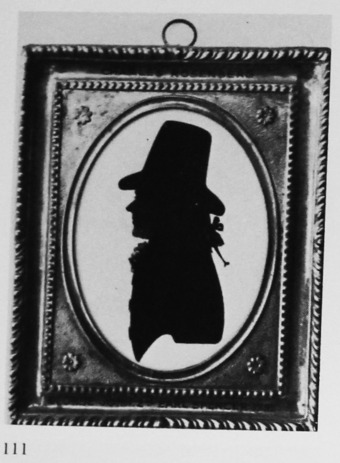
George John, Viscount Althorp, second Earl Spencer
Silhouette by Charles Rosenberg, 1791.
costume dating points
The pigtail wig, apparently tied with a large bow.
The round hat, showing the fashionable tall crown of the early 1790s, can be contrasted with that shown in 109, which was in fashion about three years earlier.
The cravat without bows: a style worn by the fashionable only for riding.
By permission of the Right Hon. Earl Spencer
Chapter 5
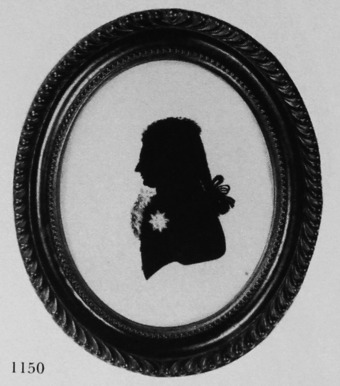
Prince Frederick, Duke of York and Albany
Silhouette painted on flat glass
1788
4 7/8 x 3 7/8 in./124 x 99mm.
Trade Label No. 1
Frame: oval, hammered brass
This is one example from a group of silhouettes of royal sitters by Rosenberg. Inscribed with the Duke’s name and title. The sitter, however, looks older than twenty-five (the Duke’s age in 1788).
From the collection of the late J. C. Woodiwiss
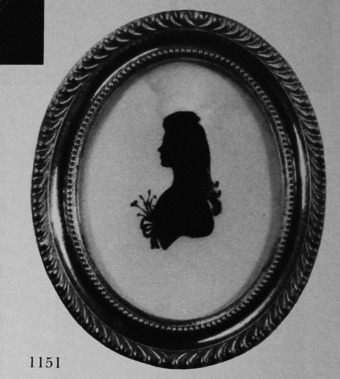
Princess Sophia
Silhouette painted on flat glass
c. 1788
4 7/8 x 3 7/8 in./124 x 99mm.
Trade Label No. 1
Frame: oval, hammered brass
From the same group of silhouettes of royal sitters as the example illustrated in 1150. The fourth daughter and twelfth child of George III, Princess Sophia (1777-1848) never married.
Author’s collection
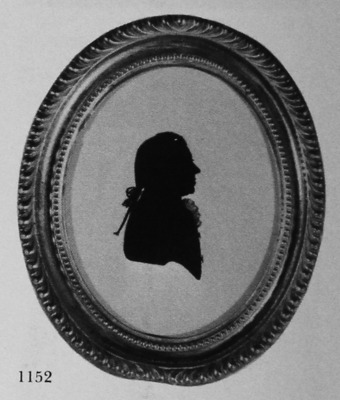
Unknown man
Silhouette painted on flat glass
c. 1790
4 7/8 x 3 7/8 in./124 x 99mm.
Trade Label No. 1
Frame: oval, hammered brass
Author’s collection
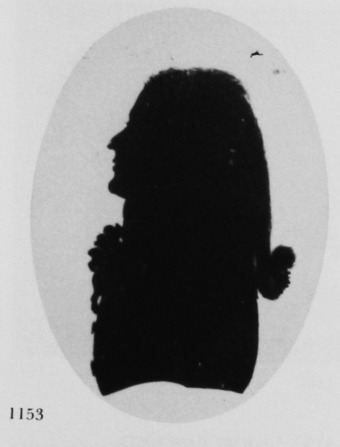
Unknown man
Silhouette painted on flat glass, with verre églomisé border
? c. 1792-93
3 ¼ x 2 ¾ in./83 x 70mm.
Trade Label No. 2
Frame: pearwood
In private possession
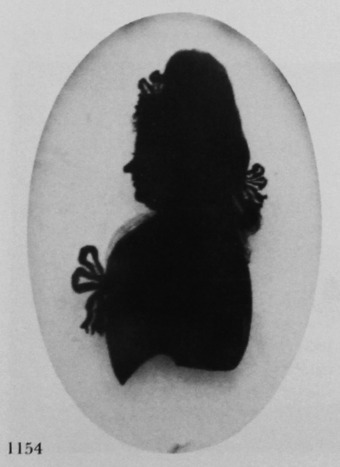
Unknown woman
Silhouette painted on convex glass, with verre églomisé border, backed with plaster slab
c. 1793
3 x 2 3/8 in./77 x 61mm.
Trade Label No. 2
Frame: pearwood
Bristol Art Gallery
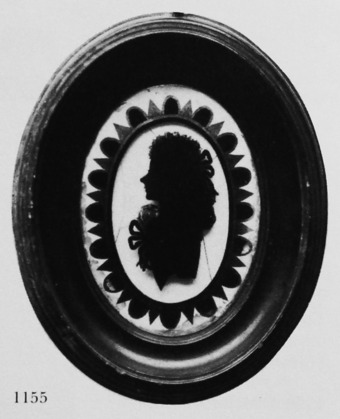
? Princess Augusta
Silhouette painted on convex glass, with verre églomisé border
c. 1793-94
Trade Label No. 2
3 x 2 3/8 in./77 x 61mm.
Frame: pearwood
Crown Copyright. Victoria and Albert Museum
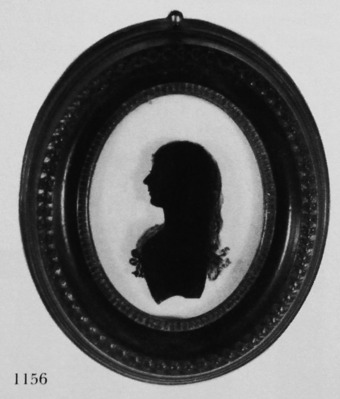
Miss E. Paynter
Silhouette painted on convex glass, backed with plaster slab
1796
3 1/8 x 2 3/8 in./80 x 61mm.
Trade Label No. 2
Frame: oval, decorated wood
Author’s collection
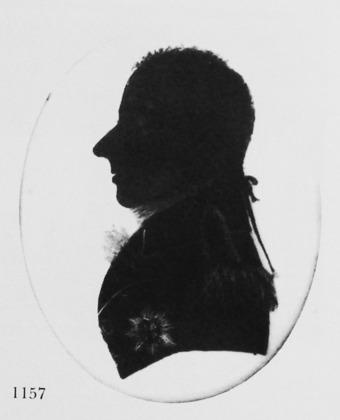
John Pitt, second Earl of Chatham
Silhouette painted on convex glass
c. 1800
2 ¾ x 2 ¼ in./70 x 58mm.
Trade Label No. 4, printed on blue paper
Frame: papier mâché
M. A. H. Christie collection
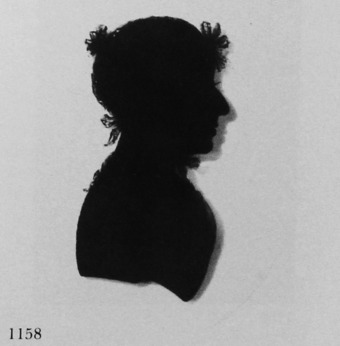
Mary Elizabeth, Countess of Chatham
Silhouette painted on convex glass
c. 1800
2 ¾ x 2 ¼ in./70 x 58mm.
Trade Label No. 4, printed on blue paper
Frame: papier mâché
M. A. H. Christie collection
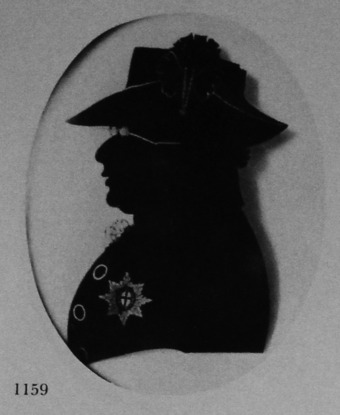
George III
Silhouette painted on convex glass
c. 1802
3 x 2 ½ in./77 x 64mm.
Trade Label No. 5
Frame: papier mâché
By gracious permission of Her Majesty the Queen
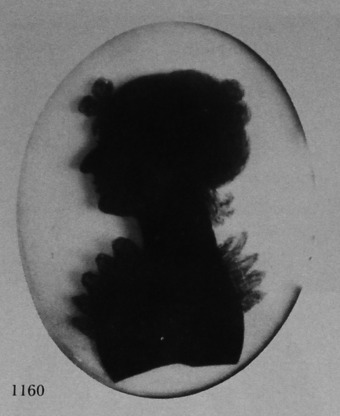
Miss Frances Letitia Earle
Silhouette painted on convex glass, backed with plaster slab
c. 1806
2 7/8 x 2 ¼ in./74 x 58mm.
Trade Label No. 6, printed on green paper
Frame: papier mâché
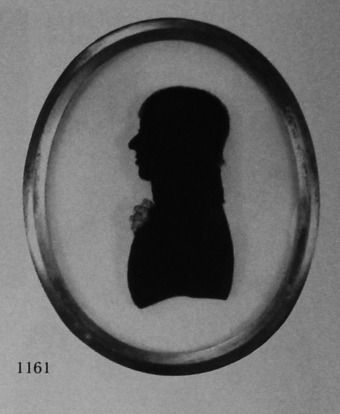
Arthur James Plunkett
Silhouette painted on convex glass, backed with plaster slab
? c. 1808
3 x 2 ¼ in./77 x 58mm.
Trade Label No. 8
Frame: papier mâché
Inscribed, ‘Master Plunkett, Killean Castel, Co. Meath’. The sitter, the only son of the eighth Earl of Fingall and his wife Frances (née Donelan) (see Edward McGauran; Section Four), was born in Geneva on 29 March 1791. In 1817 he married Louisa Amelia Corbally, of Corbalton Hall, Co. Meath, and in 1835 he succeeded to the earldom.
Author’s collection
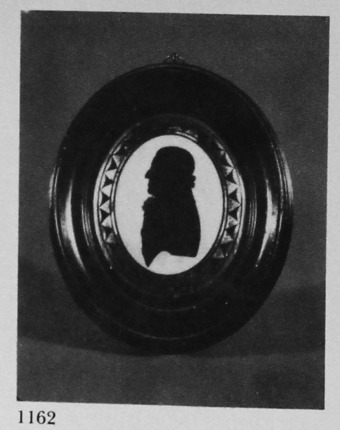
Unknown man
Silhouette painted on convex glass in the ‘Anty-Etruscan’ style, with verre églomisé border
c. 1792-93
4 x 3in./102 x 77mm.
Trade Label No. 2
Frame: pearwood
J. A. Pollak collection
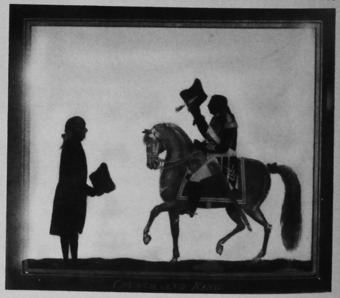
Church and King
Silhouette painted on convex glass, with verre églomisé border
c. 1790
10 x 11in./254 x 280mm.
Trade Label No. 1
Frame: giltwood
The subjects are George III and (probably) John Moore, Archbishop of Canterbury (1783-1805). A better version of this theme is illustrated in 1164.
Author’s collection
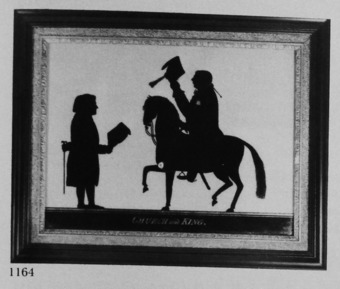
Church and King
Silhouette painted on glass
Early 1790s
9 1/2 x 13 ½ in./242 x 344mm.
Trade Label No. 1
Frame: ebonised wood, with ormolu surround
Though unlabelled, this silhouette is undoubtedly by Rosenberg. The subjects are George III and (probably) John Moore, Archbishop of Canterbury. The rendering of the Archbishop’s figure differs from that in 1163, but the likeness in the present silhouette (which is better painted) can probably be assumed to be the truer one.
M. A. H. Christie collection
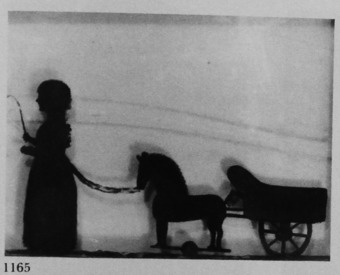
Princess Amelia
Silhouette painted on glass
? c. 1792
5 ¼ x 9in./134 x 229mm.
Trade Label No. 2
Frame: giltwood
Princess Amelia (1783-1810), who died of tuberculosis, was George III’s youngest and favourite child.
James Cartland collection
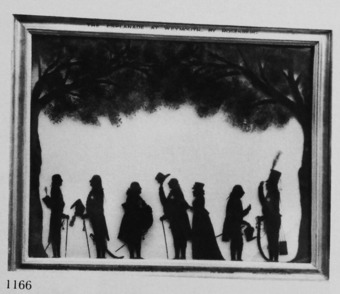
The Esplanade at Weymouth
Group silhouette painted on glass
c. 1798-99
10 ½ x 14in./267 x 356mm.
Trade Label No. 3
Frame: rectangular, giltwood
The figures are, from left to right: Sir William Fawcett, Quartermaster-general; Prince Frederick, Duke of York and Albany; the Duke of Wurtemberg (who had married the Princess Royal in 1797); George III; Queen Charlotte; the Duke of Mecklenberg-Strelitz, the Queen’s brother; George, Prince of Wales.
By permission of the Right Hon. Earl Spencer
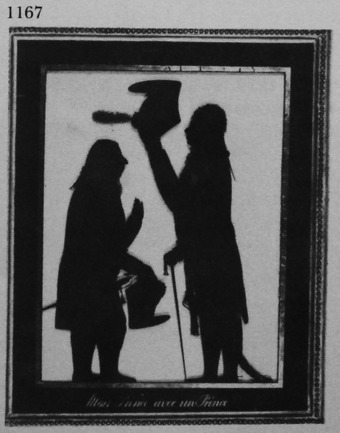
Charles, Duke of Mecklenburg-Strelitz, and George, Prince of Wales
Double silhouette painted on glass, with verre églomisé border
? c. 1806
Trade Label No. 6
The figures are probably based on those in one of the groups of royal sitters (see, for example, 1166) which Rosenberg painted at Weymouth. The touch of the blue above the riband of the Order of the Garter worn by the Duke is the only detail in colour on this otherwise black silhouette.
By gracious permission of Her Majesty the Queen
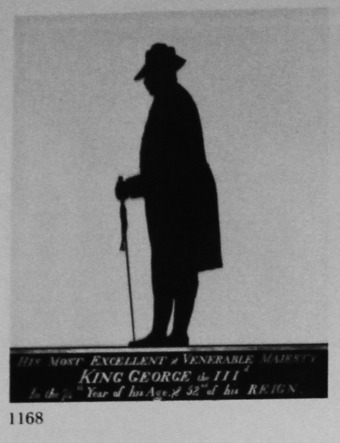
George III
Silhouette painted on glass, with verre églomisé border
? Late 1811 or early 1812
12 ½ x 10 ½ in./318 x 267mm.
Trade Label No. 10
Inscribed in the border, ‘HIS MOST EXCELLENT AND VENERABLE MAJESTY KING GEORGE THE THIRD, in the 74th year of His Age and 52nd of his REIGN.’ J. C. Stadler engraved a print (see Appendix Two) after this silhouette.
By gracious permission of Her Majesty the Queen
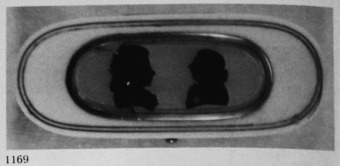
Toothpick case, with silhouettes of George III and Queen Charlotte painted on glass (backed with shiny orange paper) by Charles Rosenberg.
c. 1792-94
Size of case: 1 3/8 x 3 in./35 x 77mm.
Author’s collection
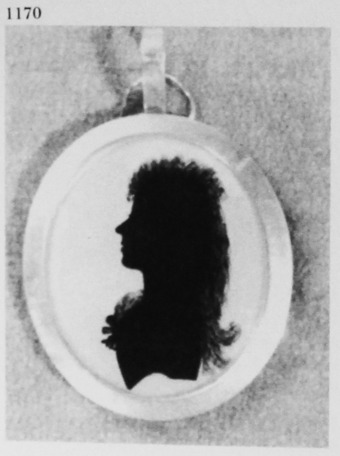
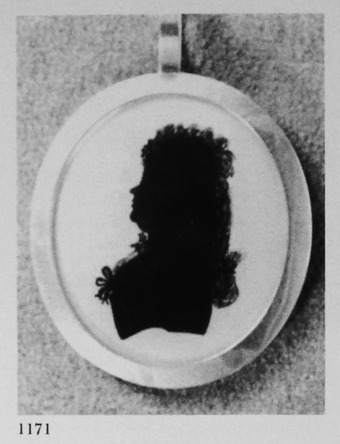
Two sides of a double locket containing silhouettes of (probably) Princess Augusta (left) and Princess Elizabeth, daughters of George III, painted on glass in the ‘anti-Etruscan style’ by Charles Rosenberg, c. 1792-93.
Size of glass: 1 ¼ x 1in./32 x 26mm.
Author’s collection
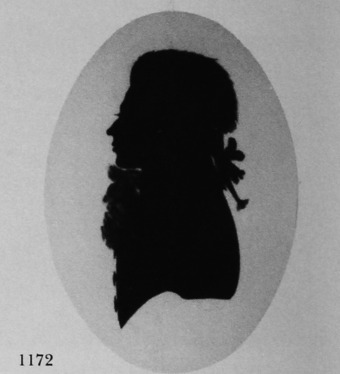
Gold Locket with plain gold back, containing a silhouette of an unknown man painted on glass, against a background of brilliant red, by Charles Rosenberg, ?c. 1792; possibly an example (see text).
Size locket: 2 1/8 x 1 ¼ in./53 x 32mm.
M. A. H. Christie collection
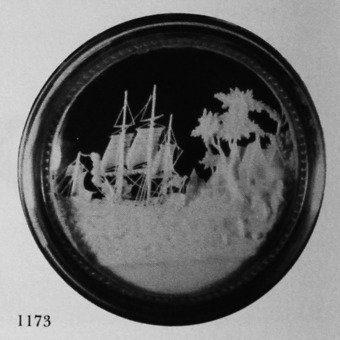
A typical carving by Stephany and Dresch, the ivory carvers who worked in partnership with Charles Rosenberg for a period during the 1790s. This example is backed with blue Bristol glass and is in a papier mâché frame. Diameter: 2 ¼ in./58mm.
Author’s collection
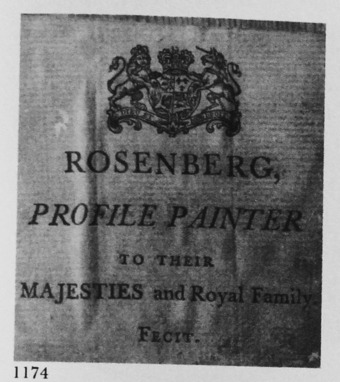
Trade Label No. 1 of Charles Rosenberg, from the silhouette illustrated in 1152.
Author’s collection
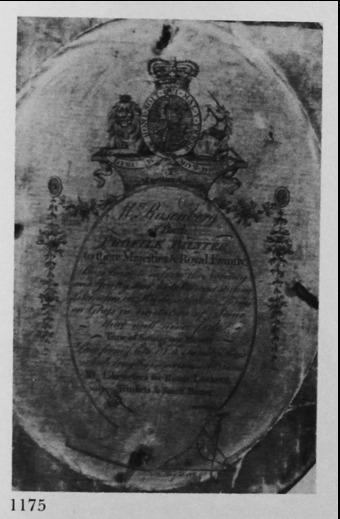
Trade Label No. 2 of Charles Rosenberg, from the silhouette illustrated in 1153.
In private possession
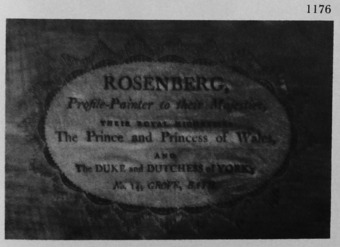
Trade Label No. 3 of Charles Rosenberg, from the silhouette illustrated in 1166.
By permission of the Right Hon. Earl Spencer
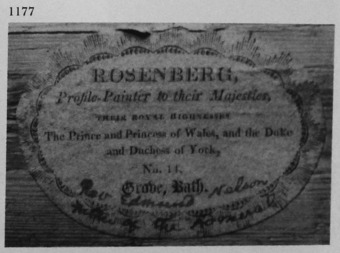
Trade Label No. 4 of Charles Rosenberg, from the silhouette illustrated in 123.
T. E. F. Sainsbury collection
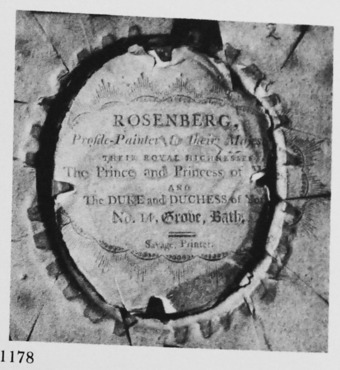
Trade Label No. 5 of Charles Rosenberg, from the silhouette illustrated in 1159.
By gracious permission of Her Majesty the Queen
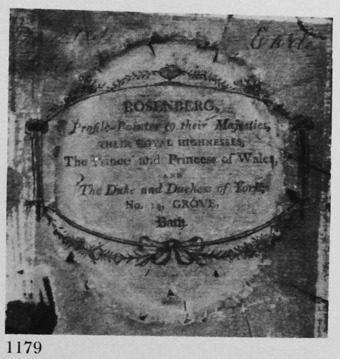
Trade Label No. 6 of Charles Rosenberg, from the silhouette illustrated in 1160.
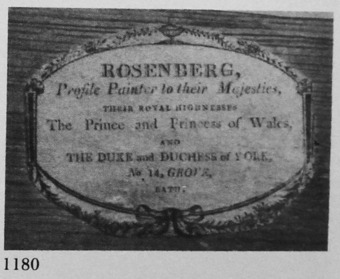
Trade Label No. 7 of Charles Rosenberg.
Holborne of Menstrie Museum, Bath; No. M.188
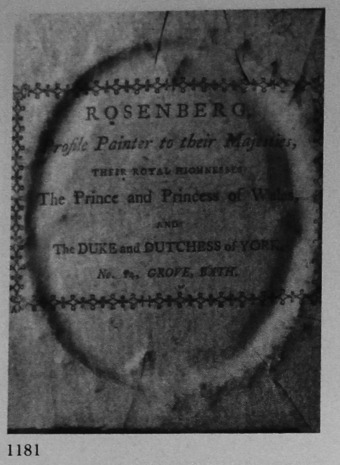
Trade Label No. 8 of Charles Rosenberg, from the silhouette illustrated in 1161.
Author’s collection
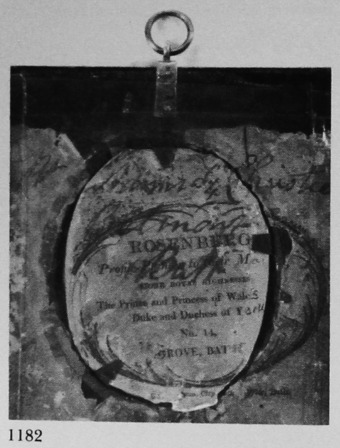
Trade Label No. 9 of Charles Rosenberg, from the silhouette illustrated in 1564.
Author’s collection
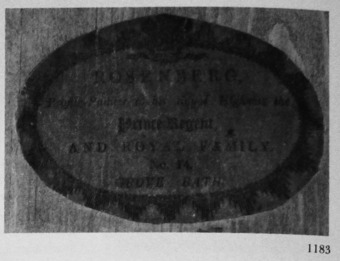
Trade Label No. 10 of Charles Rosenberg, from the silhouette illustrated in 1168.
By gracious permission of Her Majesty the Queen
DETAIL
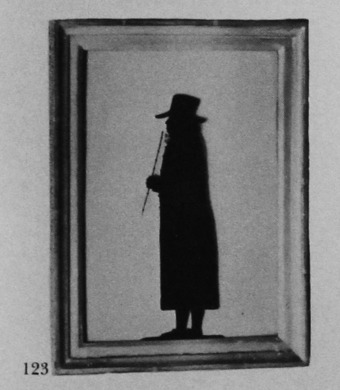
Shirt-frill. Detail from a silhouette of a man by Charles Rosenberg. The shirt-frill s rendered crudely in the artist’s characteristic style. (1152)
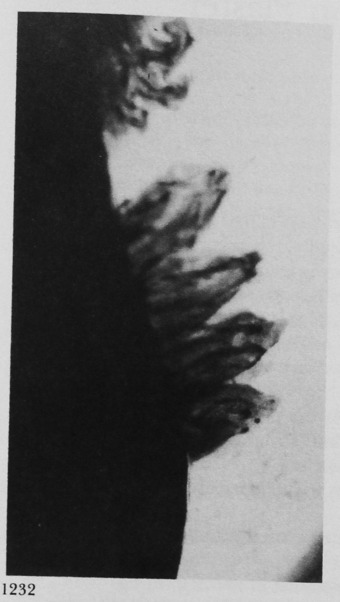
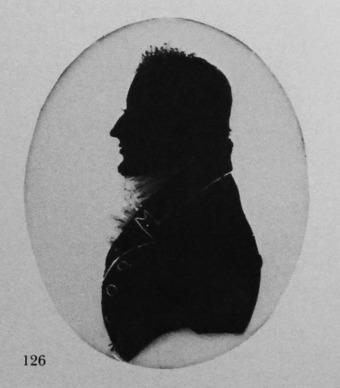
Unknown man
Silhouette by Charles Rosenberg, c. 1806.
costume dating points
The à la Brutus hair-style.
The cravat of the time, but apparently not coloured.
The single-breasted tail-coat, with the M notch, which came into fashion in 1803, and the three buttons, all of which were fastened.
From Dyrham Park, by courtesy of the National Trust
SECTION THREE
